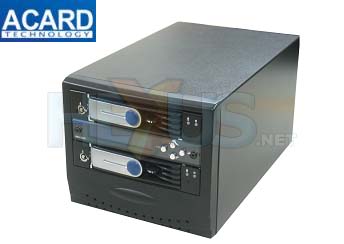External RAID enclosures for SATA drives aren't new, but ones with a SCSI interface to the host? Now that's different, but just how useful?
A new device from ACard Technology sports a chassis which can accommodate two SATA hard drives, running them in RAID 1 for data redundancy. There's an LCD display for controlling the device, automated e-mails for when a drive goes tits up and upgradeable firmware.
What's weird though, is the choice of interfaces between the 'Mirror Smart' and its host. There's USB2.0 - right, that's fine - or there's Ultra 160 SCSI... eh?
The use for USB2.0 is obvious, but we're trying to work out what's with the Ultra 160 models. Two IDE models exist too, which also have an Ultra 160 SCSI interface. Present the facts and the use of Ultra 160 seems rather strange. SCSI controllers can't be found on most motherboards by default, except server types, and this device looks more suited for SOHO/small business. Further, with SATA capable of 150MiB/s (no talk of SATA 300, so we're presuming here,) and with no performance gain from RAID 1, why not just use an eSATA interface? It saves having to mess with the data with a bridging chip and seems better geared towards furture motherboards.

Still, ACard do provide bundles with SCSI cards, and it's said to support Windows, Mac, Linux, Solaris and FreeBSD. So if you really fancy a SATA-to-SCSI enclosure, get yourself a Mirror Smart.













